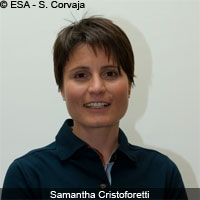Europe expands space corps with six new members
On 20 May, the European Space Agency (ESA) presented six new recruits to the European Astronaut Corps: Samantha Cristoforetti and Luca Parmitano from Italy; Alexander Gerst from Germany; Andreas Mogensen from Denmark; Timothy Peake from the UK; and Thomas Pesquet from France. They will train to prepare for missions to the International Space Station (ISS) before becoming Europe's new astronauts. The astronauts-to-be are the first to join the Corps since 1992. The 6 were selected from 8,413 applicants to the ESA's Europe-wide recruitment process that started in May last year. The applicants went through a range of psychological, medical and professional screening tests so that the search team could identify their physical and psychological strengths (e.g. visual memory and psychomotor aptitude) and technical skills. 'These young men and women are the next generation of European space explorers,' said Simonetta Di Pippo, ESA Director of Human Spaceflight. 'They have a fantastic career ahead, which will put them right on top of one of the ultimate challenges of our time: going back to the Moon and beyond as part of the global exploration effort.' Most of the applications were received from Germany and France, but a significant number came from Spain, Italy and the United Kingdom. Women submitted 16% of the applications. The new team's female member, Lieutenant Samantha Cristoforetti, has studied in France, Germany, Italy and Russia, and holds Master's degrees in Engineering and Aeronautical Sciences. A fighter pilot with the Italian Air Force, she enjoys mountaineering, scuba diving and caving in her spare time. The recruits will start their basic astronaut training at the European Astronaut Centre (EAC), along with new recruits representing other ISS partners. They are expected to be ready for space missions to the ISS by 2013. The space station has been in orbit for over a decade, and is scheduled for completion between 2011 and 2015. 'We are at a turning point in ESA's human spaceflight activities,' said ESA Director-General Jean-Jacques Dordain. 'Last year, with the launch of the Columbus laboratory and the Jules Verne Automated Transfer Vehicle, ESA became a fully-fledged member of the International Space Station partnership,' he added. 'We are now entering a new phase of utilisation of the unique capabilities offered by the ISS and preparation for international exploration of the Moon and beyond.' The Columbus Laboratory is Europe's first permanent human outpost in orbit, and is dedicated to collecting scientific data in a wide range of fields, including plant biology, exobiology, solar physics, human physiology and fluid science. It arrived at the ISS in February 2008 and was attached to the right side of ISS's 'Node 2'. Japan's Kibo Laboratory has since been attached to the other side. The Jules Verne is an unmanned logistics spacecraft. It can carry up to 7.7 tonnes of cargo, and it delivers provisions, scientific payloads and rocket propellant to the space station. It can also use its engines to boost the station higher in its orbit, effectively counteracting the drag from the Earth's atmosphere. % According to Mr Dordain, the new astronauts will need to be able to draw on the experience of seasoned astronauts so that they can become 'the representatives of Europe in space who, together with their international colleagues, will live, work, explore and bring back to planet Earth and its citizens their unique experience, their accomplishments and their confidence in the future. They all represent the generation that will move from Low Earth Orbit to the Moon', he said. Ms Di Pippo said, 'With the ISS lifetime being considered for an extension to 2020 and beyond, I believe today's selection of six new astronauts shows where Europe stands.' In 2002, the ESA Council decided to create a single corps of astronauts in Europe. Accordingly, the activities planned for the new astronauts include not only ESA missions, but those planned in cooperation with the Italian Space Agency (ASI) and National Aeronautics and Space Administration (NASA) as well.
Countries
Germany, Denmark, France, Italy, United Kingdom



